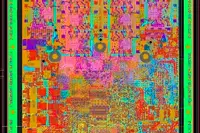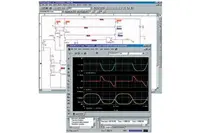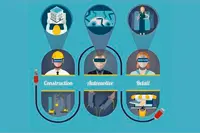Electronics News
Archive : 10 February 2016 год
 Panasonic, Hiroshima University and the Japanese National Institute of Information and Communications Technology claim to have developed a terahertz (THz) transmitter capable of signal transmission at a per-channel data rate of over 10Gbit/s over multiple channels at around 300GHz, with the aggregate multi-channel data rate said to exceed 100Gbit/s.
Panasonic, Hiroshima University and the Japanese National Institute of Information and Communications Technology claim to have developed a terahertz (THz) transmitter capable of signal transmission at a per-channel data rate of over 10Gbit/s over multiple channels at around 300GHz, with the aggregate multi-channel data rate said to exceed 100Gbit/s.
This technology could open a new frontier in wireless communication with data rates ten times higher than current technology allows. The group’s transmitter is claimed to cover the frequency range from 275 to 305GHz. This frequency range is currently unallocated and is due to be discussed at the World Radiocommunication Conference (WRC) 2019.
The THz band’s frequencies are higher than those used by the millimetre-wave wireless local area network (from 57 to 66GHz), and the available bandwidths are wider. Since the speed of a wireless link is proportional to the bandwidth in use, THz is said to be suited to ultrahigh-speed communications.
Today, most wireless communication technologies use frequencies of 5GHz or below, with high-order digital modulation schemes, such as the quadrature amplitude modulation (QAM), to enhance data rates within limited bandwidths available. The research group says that QAM is feasible at 300GHz with CMOS and that THz wireless technology could offer a boost in wireless communication speed.
Minoru Fujishima, professor at Hiroshima University, said: “Today, we usually talk about wireless data-rates in Mbit/s or Gbit/s. But I foresee we’ll soon be talking about Tbit/s. That’s what THz wireless technology offers. Such extreme speeds are currently confined in optical fibres. I want to bring fibre-optic speeds out into the air.”
Prof Fujishima added that the research group plans to further develop 300GHz ultrahigh-speed wireless circuits.
Author
Tom Austin-Morgan
Source: www.newelectronics.co.uk
 Innovate UK has formed a UK based collaboration to develop sensing technologies for the real time monitoring of machined metal parts. The ‘Intelligent Tooling’ project is developing embedded sensors and electronic components within high value machining applications in manufacturing sectors including aerospace, rail, automotive, marine and energy.
Innovate UK has formed a UK based collaboration to develop sensing technologies for the real time monitoring of machined metal parts. The ‘Intelligent Tooling’ project is developing embedded sensors and electronic components within high value machining applications in manufacturing sectors including aerospace, rail, automotive, marine and energy.
The project brings together end users and partners to integrate research, technology and industrial scale manufacturing, with the Centre for Process Development (CPI), BAE Systems, Element Six, The Advanced Manufacturing Research Centre, Advanced Manufacturing Ltd, Printed Electronics Limited, The National Physical Laboratory and DMG Mori Seiki involved.
“CPI’s role in the project is to design and print the electronic sensors, providing expertise in the integration of conventional and printable electronics,” said Dr Peter Tune, business manager at CPI. “Printing will be used where its flexible properties provide great impact. Here it is used to apply sensing functionality close to the cutting edge of the tooling inserts.”
Small variation in input parameters, such as material and tooling properties, are often only observed in the final inspection of products. Within the high value manufacturing sector, this often leads to conservative parameters or conservative tool lives being enforced. The ability to obtain data on the machining process at the time of cutting, at a lower cost and higher resolution than before allows these small changes to be diagnosed and managed within the process, leading to better tool utilisation and improved processing times.
The Intelligent Tooling project will seek to develop a prototype tooling insert with embedded sensing capability, designed to withstand and exceed the harsh environmental conditions that are present in metal machining. Further developmental focus will be to upscale the prototype to derive the data needed for commercial market adoption.
Dr Tune added: “This project represents a tough challenge for printed sensing and the learning will be directly transferrable to other embedded sensor applications where there are similar challenges.”
Author
Tom Austin-Morgan
Source: www.newelectronics.co.uk
 Lindsley Ruth, appointed chief executive of Electrocomponents in April 2015, says he is in the early stages of a ‘cultural transformation’ at RS Components.
Lindsley Ruth, appointed chief executive of Electrocomponents in April 2015, says he is in the early stages of a ‘cultural transformation’ at RS Components.
“We’re working to build the electronics business,” he said, “but need to implement such things as batch traceability.” Two ‘hidden gems’ will help RS on its way, Ruth contended. “Design Spark and the private label business we have just refocused.”
Ruth cannot be accused of having low ambitions. “At the moment, 30% of our revenues are from electronics, but I believe we can get to the revenue levels of Digi-Key by adding the best franchises, more lines and more availability. We also need a better semiconductor presence in the US.” He added that, in his opinion, Mouser was currently the best performer in the high service sector
Alluding to cultural issues, Ruth pointed out that RS ‘needs to capture the minds of engineers and buyers’. “In the next couple of years, we need to excel at the basics.”
One of the immediate tasks is to improve its customer service. “They aren’t always finding what they want,” he admitted. “We need response times on the RS website to be less than 2s, we need to improve product management and we need to manage the range effectively.
“Distribution isn’t complicated,” he concluded.
Pic: Lindsley Ruth, chief executive of Electrocomponents
Author
Graham Pitcher
Source: www.newelectronics.co.uk
 A team from Abaco Systems’ Towcester facility has won the overall prize in Mentor Graphics’ Technology Leadership Awards. The awards scheme recognises innovative solutions to system design challenges.
A team from Abaco Systems’ Towcester facility has won the overall prize in Mentor Graphics’ Technology Leadership Awards. The awards scheme recognises innovative solutions to system design challenges.
The Abaco team designed a 3U VPX single board computer on a short timescale, whilst dealing with significant challenges, including the provision of 27 voltage rails to an Intel Xeon D processor and thermal management.
“This award reaffirms that Abaco Systems has the capability to produce world class solutions for a very demanding market,” said Bernie Anger, CEO of Abaco Systems. “This is the sixth time we have entered the competition, and the fifth time we have won. We’re delighted to receive this recognition from Mentor Graphics.”
Author
Graham Pitcher
Source: www.newelectronics.co.uk
 The 2016.03 release of HSPICE, FineSim and CustomSim simulators from Synopsys will include a native environment for simulation management and analysis; a move which the EDA company claims will improve analogue verification productivity.
The 2016.03 release of HSPICE, FineSim and CustomSim simulators from Synopsys will include a native environment for simulation management and analysis; a move which the EDA company claims will improve analogue verification productivity.
The move will provide designers with access to the advanced features available in Synopsys SPICE and FastSPICE simulators, while eliminating the need to use third party environments.
Geoffrey Ying, director of product marketing for analogue and mixed signal products, said the upgrade offers three things that ‘redefine circuit simulation. “For the last 30 years, simulators have been point tools, but will now ship in a native environment. The environment will support all the latest analysis features and provide a set of features not found in other environments.”
Author
Graham Pitcher
Source: www.newelectronics.co.uk
 A report from Beecham Research suggests that, while most of the hype around augmented reality (AR) has tended to focus on consumer technology, growth in demand over the next five years will come from business applications.
A report from Beecham Research suggests that, while most of the hype around augmented reality (AR) has tended to focus on consumer technology, growth in demand over the next five years will come from business applications.
According to the report – Augmented Reality and Wearable Technology – manufacturing, logistics, healthcare and retail are likely to be among the most active markets, with AR offering a new way for people to interact with information hands-free, to provide a greater depth of control and access to knowledge.
The report highlights a number of recent acquisitions that reflect a growing level of market activity and consolidation, including PTC’s purchase of Vuforia for $65million to support its next generation of technology solutions for manufacturers. This follows acquisitions of IoT companies ThingWorx and Axeda.
Recently, the Financial Times reported that Apple had set about assembling a team of experts specialising in VR and AR and would be looking to build prototypes of headsets to rival the Oculus Rift or the Microsoft’s Hololens.
“It is clear the overall status of the enterprise market for AR and wearable technology is at a tipping point, moving from trials and testbed projects to real commercial deployments,” said Matthew Duke-Woolley, Beecham Research analyst and author of the report.
Valerie Riffaud-Cangelosi, Epson’s new markets development manager, agrees and believes the market is set for strong growth. “We unveiled our first AR product – the Moverio BT-100 – five years ago. Today, our BT-200 smart glasses offer both video and access to new AR experiences for a variety of commercial and vertical market applications.
“What is a significant change is that we are now seeing new products being brought to market that are very affordable.”
The report looks at some of the emerging business applications of AR and wearable technology, such as: head up displays in manufacturing systems to support complex production processes; collaborative product design and prototyping; remote assistance of specialist distant engineers and technicians; medical systems to enable surgeons to access relevant data in theatre without being distracted; and education and training.
At the year’s CES in Las Vegas, Intel launched Smart Helmet, said to be capable of delivering ‘x-ray like vision’.
Co-developed with the augmented reality company Daqri and using Intel’s latest processor and camera technology, Smart Helmet has been designed primarily for the industrial market. It will allow the wearer to effectively peer into the workings of objects using real-time overlay of information – such as wiring diagrams and schematics – and see problem areas that need fixing.
“Current human-computer interfaces in mobile computing are primarily based around touchscreens, but AR – along with wearable technology – enables greater interaction with information and the user’s surroundings,” said Saverio Romeo, principal analyst at Beecham Research. “We expect to see rapid evolution of smart glasses, with more miniaturisation, better field of view and battery life, while there will also be increasing attention on the convergence with VR technology and the IoT to deliver a greater competitive advantage. Collaboration with AR/VR and IoT players will be crucial.”
According to Duke-Woolley: “While it is still questionable to provide a firm forecast, if this speed of transition accelerates as companies quickly recognise the benefits and return on investment, we believe the market could quite possibly reach $800m by 2020.”
Author
Neil Tyler
Source: www.newelectronics.co.uk

